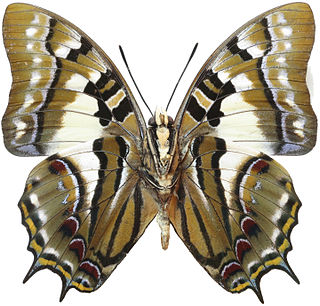
The Christmas frigatebird, or Christmas Island frigatebird, is a seabird of the frigatebird family Fregatidae which is an endemic breeder to Christmas Island in the Indian Ocean. Apart from the Ascension frigatebird, the three other species of frigatebird have much more widely distributed breeding locations.

Phalanta phalantha, the common leopard or spotted rustic, is a sun-loving butterfly of the nymphalid or brush-footed butterfly family.

Polyura delphis, the jewelled nawab, is a butterfly found in India and Southeast Asia that belongs to the rajahs and nawabs group, that is, the Charaxinae subfamily of the brush-footed butterflies family. The front wings have a concave outer edge and hind wings bear two tails.The upperside is white, largely marked with brown at the apex of the forewings. The reverse is metallic white decorated with yellow chevron lines and red marks. The wingspan is about 2.75 inches (70 mm).

The rajah and pasha butterflies, also known as emperors in Africa and Australia, make up the huge type genus of the brush-footed butterfly subfamily Charaxinae, or leafwing butterflies. They belong to the tribe Charaxini, which also includes the nawab butterflies (Polyura). Charaxes are tropical Old World butterflies, with by far the highest diversity in sub-Saharan Africa, a smaller number from South Asia to Melanesia and Australia, and a single species in Europe. They are generally strong flyers and very popular among butterfly collectors.

Polyura is a subgenus of butterflies also referred to as Nawab butterflies and belonging to the brush-footed butterfly subfamily Charaxinae, or leafwing butterflies. Like the large and conspicuous forest queens, they belong to the genus Charaxes, unique genus of the tribe Charaxini.

Cirrochroa thais, also known as the Tamil yeoman, is a species of nymphalid butterfly found in forested areas of tropical Sri Lanka and India. It is the state insect of Tamil Nadu, an Indian state.

Phalanta alcippe, the small leopard, is a butterfly of the nymphalid or brush-footed butterfly family found in Asia.
Charles William Andrews F.R.S., was a British palaeontologist whose career as a vertebrate paleontologist, both as a curator and in the field, was spent in the services of the British Museum, Department of Geology.

Morpho deidamia, the Deidamia morpho, is a Neotropical butterfly. It is found in Panama, Nicaragua, Costa Rica, Suriname, Bolivia, Venezuela, Colombia, Peru, Ecuador, and Brazil. It is a species group, which may be, or may not be several species. Many subspecies have been described.

Polyura jupiter is a butterfly of the family Nymphalidae. It is found in Indonesia and surrounding islands.

Charaxes macclounii, the wild-bamboo charaxes or red coast charaxes, is a butterfly in the family Nymphalidae. It is found along the coast of Kenya, as well as in Tanzania, the Democratic Republic of the Congo, north-eastern Angola, Burundi, Zambia, Malawi, Mozambique and eastern and northern Zimbabwe.

Charaxes latona, the orange emperor, is a butterfly of the rajahs and nawabs group, i.e. the Charaxinae group of the brush-footed butterflies family. It is native to the tropical rainforests of eastern Indonesia, western Melanesia and far northern Queensland, Australia, where it is limited to the Iron Range.

Polyura hebe, the plain nawab, is a butterfly belonging to the brush-footed butterflies family (Nymphalidae).

Charaxes distanti is a butterfly in the family Nymphalidae. It was described by Eduard Honrath in 1885. It is found in the Indomalayan realm.

Charaxes borneensis, the White Banded Rajah, is a butterfly in the family Nymphalidae. It was described by Arthur Gardiner Butler in 1869. It is found in the Indomalayan realm.

Charaxes affinis is a butterfly in the family Nymphalidae. It was described by Arthur Gardiner Butler in 1866. It is found in the Indomalayan realm.

Charaxes (Polyura) cognatus, the Sulawesi blue nawab, is a butterfly in the family Nymphalidae. It was described by Samuel Constantinus Snellen van Vollenhoven in 1861. It is endemic to Sulawesi.

Charaxes (Polyura) epigenes is a butterfly in the family Nymphalidae. It was described by Frederick DuCane Godman and Osbert Salvin in 1888. It is endemic to the Solomon Islands.

Charaxes (Polyura) pyrrhus is a butterfly in the family Nymphalidae. It was described by Carl Linnaeus in his 1758 10th edition of Systema Naturae. It is found in the Australasian realm including New Guinea, Australia, Timor, Moluccas.


















